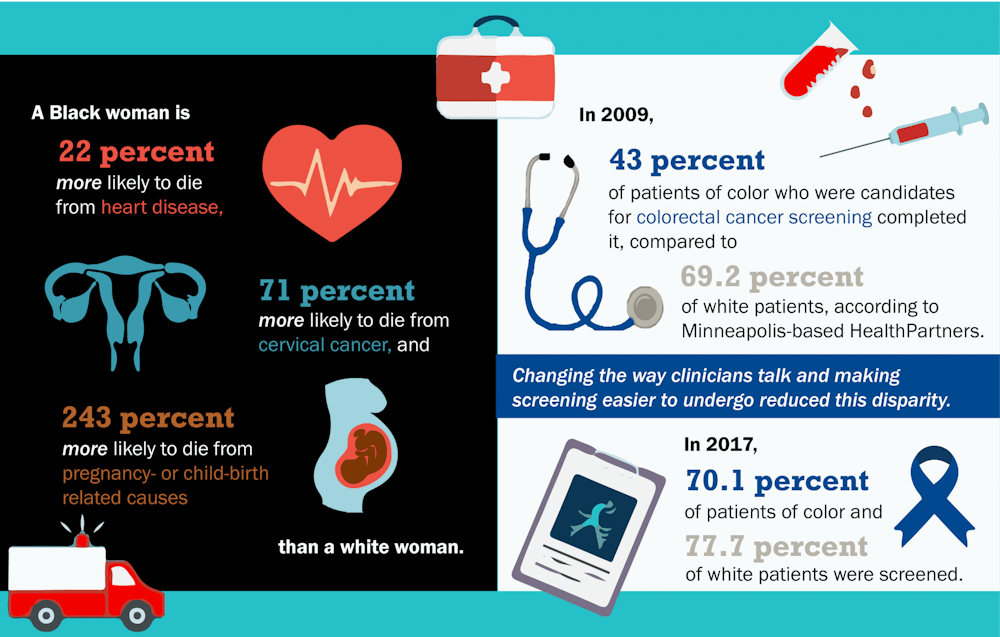I admire doctors’ mastery of medicine — knowing the intricate folds of the intestine like a memorized puzzle and navigating the maze of masked organs tucked beneath skin. They wear white coats of purity and stethoscopes of armor. They’re highly decorated, respected, and glorified. They’re calm with their tools, commanders-in-chief of the body, and menders of ailments. They care for our bodies when we aren’t sure how to — when pain inflicts itself upon us like an uninvited guest. Our bodies are our most valuable assets — an entangled blend of psychic, emotional, and physical scars. And so, living in a vessel as dynamic and ever-changing as the human body is a gift that requires multiple levels of both self-care and professional care.
Yet, what happens when rational, logical science — the very infrastructure of medicine — is clouded by racism? How does a nation that boasts its investment in healthcare face the fact that medical treatment is heavily determined by race and that pain is colored by skin?
The realms of medicine, white coats, and hospitals have been, and continue to be, deeply stained by racialized practices. In a society infiltrated by racism and inequity in almost every institution and profession, doctors and scientists have not been left behind; in fact, racism is rooted at the heart of medicine, pulsating, pounding, and remaining alive no matter whom it hurts.
In her essay “Myths about physical racial differences were used to justify slavery — and are still believed by doctors today,” an integral part of the New York Times’ 1619 Project, Linda Villarosa, the program director of journalism at the City College of New York, steers through the many raw, bleeding wounds which inhabit the historical spheres of biology and medicine. Villarosa’s piece is an evocatively honest, yet shocking, depiction of multiple persistent medical myths which continue to be taught and practiced in medical settings. Her story is not a historical archive or synopsis of medical practices, but rather a collection of voices — a mural of pain and resilience, patients whose bodies have been toyed with and weaponized by structural racism.
Villarosa brings readers into the veins of history, driving towards the multiple medical myths which have lived on through the centuries. From Thomas Hamilton, a physician keen on proving differences between Black people and white people lay within their biological construction, to Benjamin Mosely, a British doctor who believed that Black individuals could bear more painful surgical procedures, irrational assumptions about race and its effects on the body guided medical treatment for decades. Misconceptions about strength, pain, and physicality were celebrated — encouraging the continuation of treating Black patients in an aggressive and wholly unjust manner.
Many of these physicians’ theories about Black bodies’ inferiority have penetrated into modern medical practices. As Villarosa elucidates, the spirometer, a device used to measure lung function, was designed to calculate lung deficiency at 20 percent for Black patients. Today, spirometers have a “race correction” factor, which is based on the unbacked assumption that Blacks have less lung capacity than whites. Medical education which teaches students to “do no harm” rarely addresses the downstream effects of health policy, or lack thereof, and minimizes conversations of biases present in healthcare.
Against our nation’s persisting backdrop of COVID-19, data which relentlessly suggest that Black people have suffered disproportionate rates of death during the pandemic, and the killing of George Floyd, among other instances of police brutality against Black bodies, the notion of what it means to be a doctor is more important than ever. Doctors are champions of equity and committed to respecting people — mobilizing knowledge, precision, and advocacy to push the boundaries of medicine into public health, well-being, and safety. Healthcare professionals care for people during their most vulnerable moments, and it is essential that they recognize the repeated manifestations of racism as a public health crisis.
Until COVID-19, I assumed that medicine and the role of physicians lay in the ability to treat symptoms, derive diagnoses, and communicate with patients. But now, as a pre-med student, I ask myself what it is that I desire from a medical profession. I want to be able to treat others with compassion — with an undying humility that exercises itself in conversation and treatment. I want to be able to build trusting relationships, to provide care that is not muddled by color, to be immersed in medical discourse that doesn’t ignore our nation’s plague of unaffordable healthcare. I’m still grappling with the responsibility that comes with being in the healthcare sector — the humbling opportunity to amplify voices, cultivate connections between people and science, and recognize that physicians are part of a story that transcends the walls of a hospital.








